Following is the picture of the clown after coloring the shapes in it as per the instructions.
NCERT Solutions For Class 3 Maths Chapter 5 - Shapes and Designs
Shapes and Designs deals with the concept of identifying basic 2-D geometrical shapes through their sides and corners, reading map. This chapter have exercises on identifying rectangles, squares and triangles by their sides and corners. Understanding map. Making shapes using tangrams. The solutions for Math-Magic Chapter-5 have been created and verified by our experienced subject matter experts, according to the CBSE syllabus and guidelines of NCERT. For practice, our subject matter experts have created very interactive, activity-based, and Image-based worksheets on these topics to enhance learning.
Download PDF For NCERT Solutions for Maths Shapes and Designs
The NCERT Solutions For Class 3 Maths Chapter 5 - Shapes and Designs are tailored to help the students master the concepts that are key to success in their classrooms. The solutions given in the PDF are developed by experts and correlate with the CBSE syllabus of 2025-2026. These solutions provide thorough explanations with a step-by-step approach to solving problems. Students can easily get a hold of the subject and learn the basics with a deeper understanding. Additionally, they can practice better, be confident, and perform well in their examinations with the support of this PDF.
Download PDF
Access Answers to NCERT Solutions For Class 3 Maths Chapter 5 - Shapes and Designs
Students can access the NCERT Solutions For Class 3 Maths Chapter 5 - Shapes and Designs. Curated by experts according to the CBSE syllabus for 2025–2026, these step-by-step solutions make Maths much easier to understand and learn for the students. These solutions can be used in practice by students to attain skills in solving problems, reinforce important learning objectives, and be well-prepared for tests.
Shapes and Designs
Colour the clown following the directions given below:


Find the biggest rectangle in the figures given below.
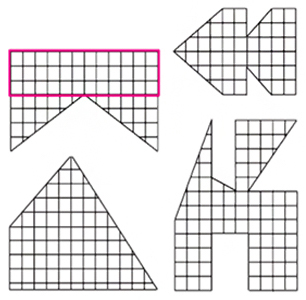
In this figure, the biggest rectangle is marked pink in colour.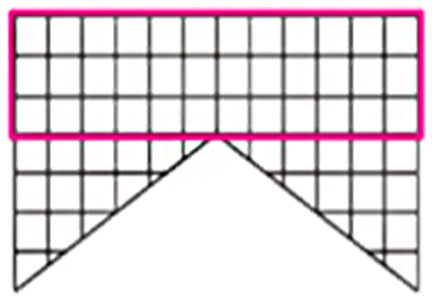
In this figure, the biggest rectangle is marked red colour.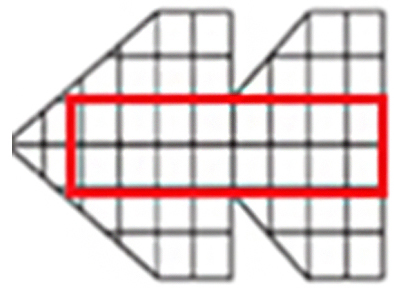
In this figure, the biggest rectangle is marked green colour.
In this figure, the biggest rectangle is marked blue colour.
How many triangles are there in the following figures?

There are 12 triangles.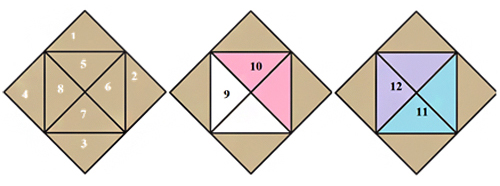
There are 14 triangles.
There are 13 triangles.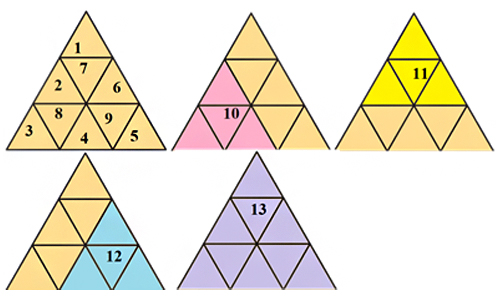
Edges and Corners
a) Look around you and identify things with straight and curved edges.
b) Do the things with straight edges have corners?
c) Do the things with curved edges have corners?
d) Try to find things which have both straight and curved edges.
Observe your surroundings and answer this question. Answers may vary.
a) Following are few examples of things with straight edges. Table, tv screen, diary, etc. Following are few examples of things with curved edges. Plates, wall clocks, tennis balls, etc.
b) Yes, the things with straight edges have corners.
c) No, the things with curved edges don’t have any corners.
d) Following are few examples of things with both straight and curved edges. Car, spoon, guitar, etc.
Meeta and her 5 friends were playing a game. Tinku was blindfolded and asked to keep clapping as long as he wished while the others would move round a table. The moment Tinku stopped clapping, everybody would stop wherever they were. The child who was not at a corner would be out. Then she/he would be blindfolded.
a) Looking at the picture given above, can you tell who is out?
b) Where is Guddu standing?
c) Can this game be played around a round table? Why?
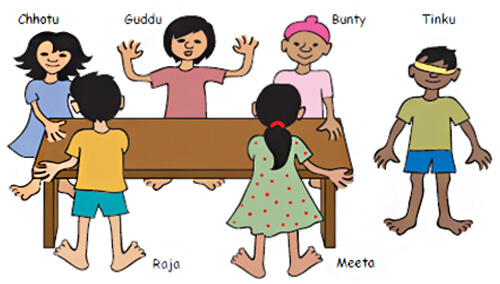
a) By the game rules, the child who was not at a corner would be out. In the picture, Guddu is not standing near the corner. So, Guddu is out.
b) Guddu is standing near the edge of the table.
c) Since there is no corner in a round table, this game cannot be played around a round table.
Activity Time
Repeat the activity with a square sheet of paper.
Do it by yourself.
(i) A square sheet has 4 corners. If 2 corners are folded then the number of corners will be 6.
(ii)A square sheet has 4 corners. If 3 corners are folded then the number of corners will be 7.
(iii) A square sheet has 4 corners. If 4 corners are folded then the number of a corner will be 8.
iv) Yes. a square sheet can be folded in such a way that it has 3 corners. It would look like a triangle.

Can you fold all the corners of the square sheet in such a way that the number of corners remains unchanged?
Yes, the corner of the square sheet can be folded in such a way that the number of corners remain unchanged.
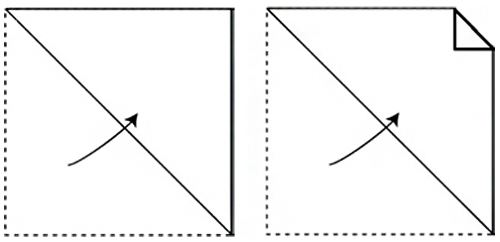
Look at the following table and tick ( ) the names of things that have corners. Also, count the number of edges and corners in each of them.
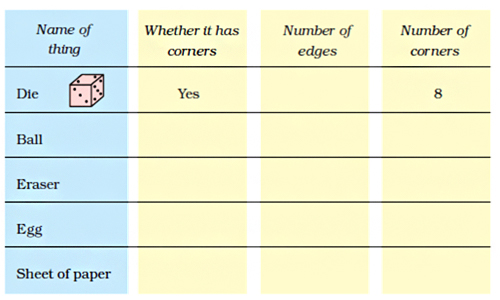
Observe the given things and fill up the table. The correct answer is:

Using only straight lines, can you draw a figure which has no corners?

No, using only straight lines it is not possible to draw a figure which has no corners.
1. Take a rectangular sheet of paper.
2. Count its corners.
3. Now fold one of its corners.
a) How many corners does it have now?
b) How many corners will you get by folding
i) 2 corners
ii) 3 corners
iii) 4 corners
c) Can you fold this paper in such a way that it has only three corners? You are allowed only two folds. What shape will you get?
Do the activity as instructed and answer the questions.
a) A rectangular sheet has 4 corners. If one corner is folded then the number of corners will be 5.
b) (i) A rectangular sheet has 4 corners. If two corner are folded then the number of corners will be 6.
(ii) A rectangular sheet has 4 corners. If 3 corner are folded then the number of corners will be 7.
(iii) A rectangular sheet has 4 corners. If 4 corner are folded then the number of a corner will be 8.
c) No, a rectangular sheet cannot be folded in such a way that it has three corners.
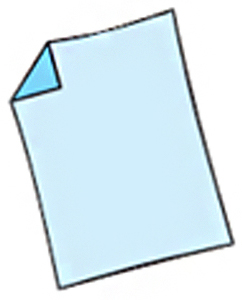
In the following figures, tick ( ) those which have corners. Do these figures have curved lines?

The correct answer is: The figures with curved lines are: Figure (i), (ii), (iv), (v), and (vii).

Tangram
How many triangles do you have in your set? Are all of them equal in size? Find out.
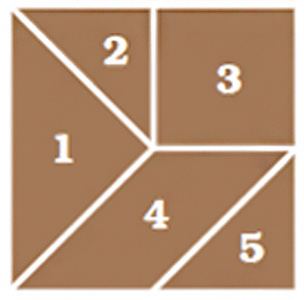
In the given set, there are a total of 3 triangles. No, all of them are not in equal sizes.
Which two pieces of the tangram set are exactly same? Find out.
Triangle 2 and triangle 5 are exactly same.
Take pieces 4 and 5 from the set and find out on which side of the triangle you can join the other piece.

Parallelogram 4 can be joined by slant side of the triangle 5.
Use the two small triangles in the tangram set to get the following shapes:

(1) Using triangle 2 and triangle 5.
(2) Using triangle 2 and triangle 5.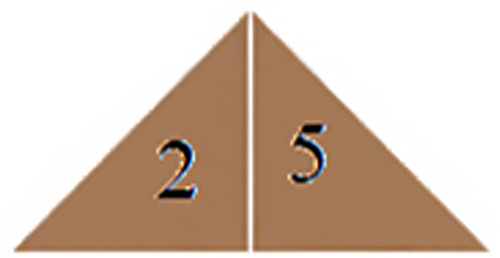
(3) Using triangle 2 and triangle 5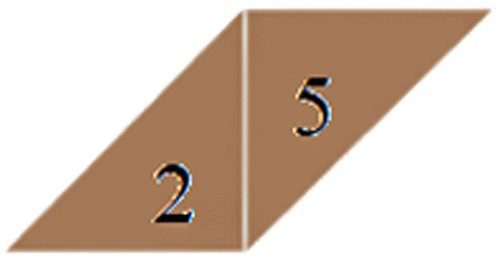
Find matching sides among the following pairs of pieces. a) Pieces 1 and 2 b) Pieces 2 and 4 c) Pieces 1 and 5 d) Pieces 2 and 5

a) The longest side of triangle 2 matches with one of the short sides of triangle 1.
b) The longest side of triangle 2 matches with one of the longest sides of parallelogram 4.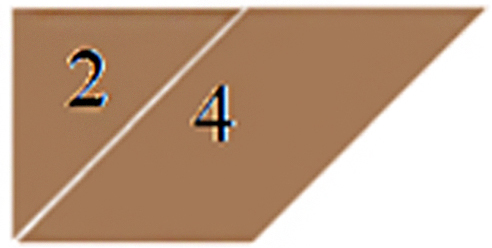
c) The longest side of triangle 5 matches with one of the short sides of triangle 1.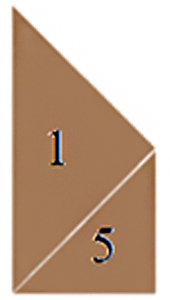
d) The longest side of triangle 2 matches with one of the longest sides of triangle 5. The short side of triangle 2 matches with one of the short sides of triangle 5.
The 7–piece tangram
Now try making the following shapes using only the pieces written here:
i) Use only triangles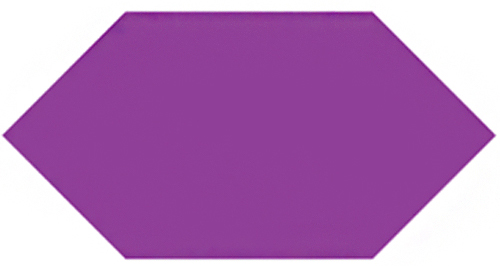
ii) Use pieces 1, 2, 3, and 5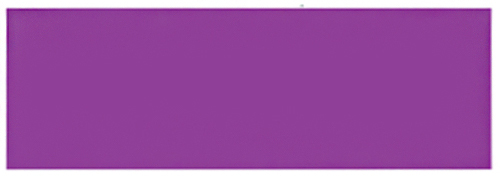
iii) Use only two triangles
iv) Use pieces 1, 2, 3, 4, and 5
i) Using shapes 1, 3, 5, 6, and 7.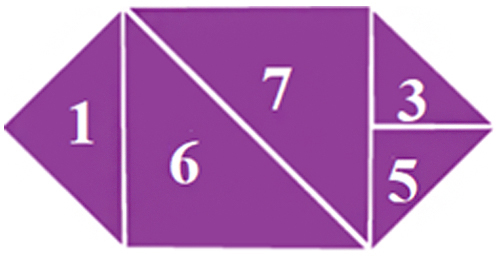
ii) Using shapes 2, 1, 3, and 5.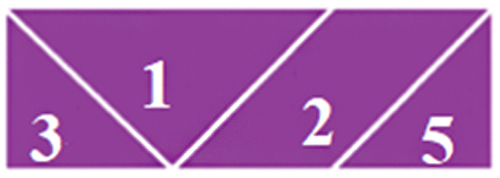
iii) Using shapes 6 and 7.
iv) Using shapes1, 2, 3, 4 and 5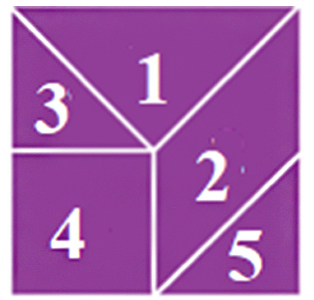
Weaving Patterns
Among the following, can you match the tiles with the designs that they will make on the floor? Draw lines to match.

The correct answer is:

Khushboo and Hariz live in Agra. One day they went to see the Taj Mahal. The floor had the pattern shown below:
What do you think? Discuss with your friends.

Observing the pattern you can find that all the tiles used in the patterns are in the shape of hexagons.
Hexagons are placed horizontally and vertically to make the floor pattern.
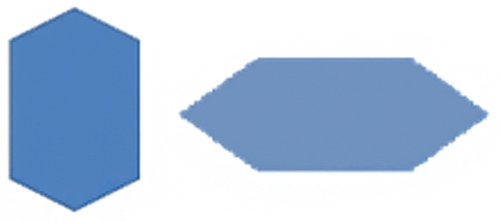
Complete the following tiling pattern.
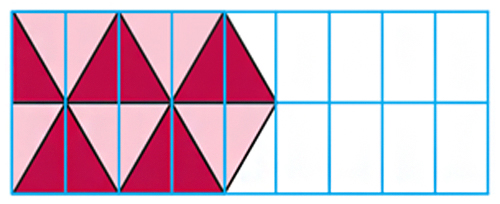
The complete tiling pattern is given below

Complete this pattern. Compare it with the pattern on page 70 which also uses six-sided shapes. What is the difference between the two?

Complete the pattern by yourself. To compare both the patterns first observe the pattern given on page 70. That pattern has hexagons that are connected by their sides. In this pattern, the hexagons are connected through triangles. This is the difference between the two designs.
Which geometrical shapes can you identify in these borders? Draw them in your notebook.
a) Is any shape repeating in a particular pattern? Which ones? Are the shapes made of
(i) Curved lines
(ii) Straight lines
(iii) Both curved and straight lines.
b) Look at your clothes, your mother's saris/shawls, rugs, and mats. Can you identify some patterns? Draw them in your notebook.

From these borders, it is easy to identify the circles, hexagons squares, triangles, parallelograms, and arcs.
a) Yes. Some shapes are repeating in a particular manner. These are hexagons, circles, squares, etc.
In the 1st pattern  and
and![]() these are repeating.
these are repeating.
In the 2nd pattern and
and ![]() these are repeating.
these are repeating.
In the 3rd pattern and
and  these are repeating.
these are repeating.
(b) (i) Yes, the shapes are made of curved lines.
(ii) Yes. The shapes are made of straight lines.
(iii) Yes. The shapes are made of both curved and straight lines.
(c) Do it by yourself
Treasure Hunt
Franke and Juhi's mummy has hidden a surprise gift for both of them. But she wants them to find out the gift through a treasure hunt. She has written some instructions here. Can you help Juhi and Franke in finding their gift?
a) Start from the tallest tree.
b) Go forward on the pathway.
c) From the sixth tile, turn left.
d) After moving a few steps again, you will find a plant on your right-hand side.
e) Colour the dress of the child playing closest to this plant.
f) Start moving again from the plant.
g) On the fourth tile, turn left again.
h) On the way, you will find the corner of the fourth tile is broken.
i) You will find a bat and a ball lying on the ground. Don't pick them up, just circle them.
j) Move ahead and turn right.
k) You will find a mango tree. A few mangoes can be seen on the tree. Colour 11 mangoes on the tree.
l) Also draw some grass near the mango tree and start moving again on the pathway.
m) When you go straight, you will find a house.
n) Behind that house there is a bag. Open it and you will find something sweet in it! Can you tell what their mother has kept in the bag?
The correct answer is:
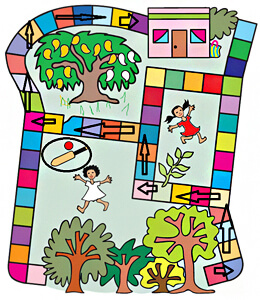
Tiling Time
Have you seen this shape in any other design — on a wall, a dress, on a basket, a mat, etc.?
Do it by yourself.
The patterns below are made from this tile.
.jpg)
By using two colours it becomes a different pattern of blue and yellow flowers.
Use different colour combinations to make your own patterns.
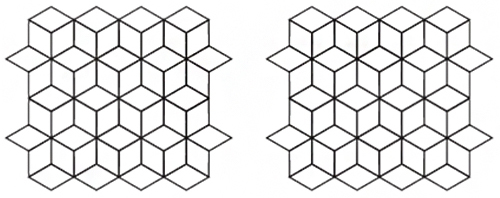
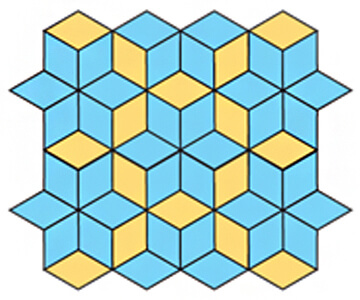
Do it by yourself. Answers may vary. A sample answer is:

Admissions Open for
Admissions Open for
Frequently Asked Questions
The NCERT solution for Class 3 Chapter 5: Shapes and Design is important as it provides a structured approach to learning, ensuring that students develop a strong understanding of foundational concepts early in their academic journey. By mastering these basics, students can build confidence and readiness for tackling more difficult concepts in their further education.
Yes, the NCERT solution for Class 3 Chapter 5: Shapes and Design is quite useful for students in preparing for their exams. The solutions are simple, clear, and concise allowing students to understand them better. Where to Look Fromally, they can solve the practice questions and exercises that allow them to get exam-ready in no time.
You can get all the NCERT solutions for Class 3 Maths Chapter 5 from the official website of the Orchids International School. These solutions are tailored by subject matter experts and are very easy to understand.
Yes, students must practice all the questions provided in the NCERT solution for Class 3 Maths Chapter 5: Shapes and Design as it will help them gain a comprehensive understanding of the concept, identify their weak areas, and strengthen their preparation.
Students can utilize the NCERT solution for Class 3 Maths Chapter 5 effectively by practicing the solutions regularly. Solve the exercises and practice questions given in the solution.
CBSE Schools In Popular Cities
- CBSE Schools in Bangalore
- CBSE Schools in Mumbai
- CBSE Schools in Pune
- CBSE Schools in Hyderabad
- CBSE Schools in Chennai
- CBSE Schools in Gurgaon
- CBSE Schools in Kolkata
- CBSE Schools in Indore
- CBSE Schools in Sonipat
- CBSE Schools in Delhi
- CBSE Schools in Rohtak
- CBSE Schools in Bhopal
- CBSE Schools in Aurangabad
- CBSE Schools in Jabalpur
- CBSE Schools in Jaipur
- CBSE Schools in Jodhpur
- CBSE Schools in Nagpur
- CBSE Schools in Ahmednagar
- CBSE School In Tumkur











